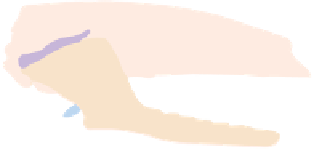Geology Reference
In-Depth Information
◗
Figure 22.29
Evolution of the Mammal Jaw and Middle Ear
a
Cynodonts had four bones in the jaw,
whereas
b
mammals have only one. Note that the cynodont jaw-skull joint is between the articular and the
quadrate bones, but in mammals, it is between the dentary and squamosal bones.
c
Cynodonts had one
middle-ear bone—the stapes—but
d
mammals have three: the malleus, the incus, and the stapes. The
malleus and incus were derived from the cynodont articular and quadrate bones.
Dentary
Angular
Squamosal
Articular
Quadrate
Jaw joint
Jaw joint
a
(a)
Reptilian jaw
(b)
Mammalian jaw
b
Middle ear
Middle ear
Eardrum
Stapes
Inner ear
Eardrum
Inner ear
Stapes
Incus (evolved
from quadrate)
Sound
Sound
Malleus (evolved
from articular)
(c)
Reptilian ear bone
c
(d)
Mammalian ear bones
d
Dimetrodon
(reptile)
Morganucodon
(mammal)
Reptiles and mammals have a bony protuberance from
the skull that fi ts into a socket in the fi rst vertebra—the atlas.
This structure, called the
occipital condyle,
is a single feature
in reptiles, but in cynodonts it is partly divided into a double
structure typical of mammals. Another mammalian feature,
the secondary palate, was partially developed in advanced
cynodonts (Table 22.2). This bony shelf separating the nasal
passages from the mouth cavity is an adaptation for eating
and breathing at the same time, a necessary requirement for
endotherms with their high demands for oxygen.
Mesozoic Mammals
Mammals evolved during the Late
Triassic not long after the fi rst dinosaurs appeared, but for
the rest of the Mesozoic Era, most of them were small. There
◗
Figure 22.30
Comparison of the Teeth of a Mammal and a Reptile
Molars
Premolars
Canine
Incisors
b
Reptiles, represented here by a crocodile, may have teeth that
vary somewhat in size, but otherwise they all look the same. The
only exception is among some mammal-like reptiles.
a
This wolf skull shows that mammal teeth are differentiated into
incisors, canines, premolars, and molars.























































































































































































































































Search WWH ::

Custom Search